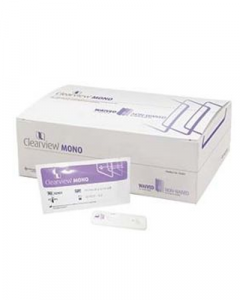
Some segments of the population do not produce detectable heterophile antibodies, eg, approximately 50% of children under 4 years of age and 10% of adolescents.

In these cases, it is difficult to disprove the possibility of concurrent disease states. These include leukemia, Burkitt lymphoma, pancreatic carcinoma, viral hepatitis, cytomegalovirus infections, and others. The IM heterophile antibody has been associated with several diseases other than IM. Thus, caution should be exercised in the interpretation of test results. Conversely, IM heterophile antibodies have been detected prior to the onset of clinical symptoms. Sometimes the doctor will do a blood test. IM heterophile antibody titers have been shown to persist in some cases for months to years after clinical symptoms have subsided. Mononucleosis - or mono - is an infection that causes flu-like symptoms. However, some false-negative results have been shown to be due to a delayed IM heterophile antibody response. Some of these may represent cases of IM that remain persistently seronegative for the IM heterophile antibody. However, you should watch for any swelling or pus, and be sure to keep the needle entry site clean after you go home.įinally, if you have any bleeding disorders or if you are taking blood-thinning medications like warfarin or aspirin, be sure to tell your doctor before the test.Approximately 10% of patients with infectious mononucleosis (IM) will have no heterophile antibody and may require Epstein-Barr virus antibody tests to confirm the diagnosis.įalse-negative results have been reported. Your healthcare provider will use an alcohol swab to wipe the place of insertion beforehand, which almost always prevents infections. A warm compress may help if you notice any swelling.Īs with all procedures that create an opening in the skin, there’s a rare chance of infection. This will typically heal on its own after a few days. You may also have a slight risk of hematoma, which is basically a bruise. Obtaining a blood sample can sometimes be difficult if the vein is particularly small or difficult to see.
/GettyImages-1248685992-b72750209f2443e0ace5b958b88d4a45.jpg)
Other complications may include soreness at the injection site, particularly if your healthcare provider had a hard time reaching your veins. They may also get you a snack and a beverage to help you recover. If you experience lightheadedness, tell your healthcare provider, and sit down in the office until it passes. Though blood tests are extremely safe, some people may feel lightheaded after it’s over. If it does, the test is considered a positive confirmation of mononucleosis.Īre there any potential complications associated with the test? Lab technicians place the blood sample on a microscope slide, mix it with other substances, and then watch to see if the blood begins to clump. A bandage is placed over the small wound afterward. McKesson Consult Mononucleosis Cassette Test qualitatively detects infectious Mononucleosis antibodies in human whole blood, serum or plasma specimens. When the tube contains enough blood, your doctor will withdraw the needle and cover the small puncture wound with a bandage.įor a finger-prick test, your healthcare provider will make a small prick in the tip of your ring finger, then squeeze to collect enough blood in a small tube to perform the test. They’ll then gently insert a small needle into the vein, allowing the blood to flow into an attached tube. Your healthcare provider will wrap an elastic band around your upper arm to make the vein fill with blood. Sometimes a simple finger-prick test may be used instead. Like most blood tests, it’s performed by a healthcare provider who draws a blood sample from a vein, usually on the inside of the elbow or the back of the hand.

The test helps to confirm a diagnosis of the illness.

This blood test is most often done once symptoms have developed, which is typically 4 to 6 weeks after exposure (this delay is referred to as the incubation period). Note: The Centers for Disease Control and Prevention (CDC) doesn’t recommend the Monospot test for general use because, while it may indicate whether you have infectious mononucleosis, it doesn’t confirm the presence of the Epstein-Barr virus. Your doctor might recommend a second test in a couple weeks or may try other tests to confirm the diagnosis. If the test comes back negative, it may mean you don’t have the infection or that the test was performed too early or too late to detect the antibodies. other infectious diseases and some cancers.On rare occasions, the test may show antibodies even though you don’t have the infection. The mononucleosis test looks for the presence of two antibodies that typically form when certain infections - like those caused by the Epstein-Barr virus - are present in the body. It includes the release of certain antibodies, or “fighter cells,” charged with going after the viral cells. When a virus infects the body, the immune system goes to work to fight it off.


 0 kommentar(er)
0 kommentar(er)
